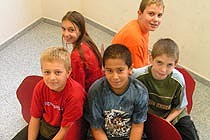
|
GRG 12 Rosasgasse, Street Furniture and Seating Thinking about the subject of street furnishing began right where the participants lived and went to school. The participants were encouraged to be consciously aware of the pedestrian zone on Meidlinger Hauptstrasse, designed by Boris Podrecca at the start of the 1990s, as the city's 'user interface'. Equipped with questionnaires and cameras the participants gathered information from the users of the shopping street, such as local proprietors, consumers, mothers with small children, local residents, street cleaners, wheelchair users, the visually challenged and senior citizens. The subjective experience of each individual showed the various demands that are made on the shopping street as a user interface. What makes it attractive or unpleasant? What provides orientation? What is obstructive or objectionable? At the end of the study the participants completed a project where they designed street furniture for semi-public space at their new school. Working in small groups they then selected a specific location in the school grounds to design furniture for. The two-day workshop ended with an excursion to the studio of the architects AllesWirdGut (AWG). Concrete seating solutions were designed for the new school in the 2nd part of the workshop. Based on the school's logo (a stylised rose), a seating flower was developed for five of their fellow pupils. The kids also planned a variable seating object with a variety of different uses for outdoor space. |
 |
|
© Max Moser |
|
Learning Offers for schools Activities for Adults Kindergarten Archikids Holiday workshops Birthdays Barrier-Free German as a foreign language Cooperations - die Graphische - a_show Audioguide (in German) - AHS Bernoullistraße - The City of the Future – p[ART] - Berufsschule für Baugewerbe - Advertising Spots 'Soviet Modernism' - Kinderuni Wien - Camillo Sitte Lehranstalt - International - For the Visually Impaired - Hunger auf Kunst und Kultur - Museum Online - platz da! - Street Furniture and Seating - StadtkomplizInnen Team Gallery: GRG 12 Rosasgasse Information: Anne Wübben Tel.: +43 (1) 522 31 15 - 29 Fax: +43 (1) 522 31 17 Email: wuebben@azw.at |
| © Architekturzentrum Wien 2025 |
||



